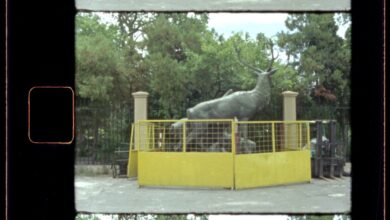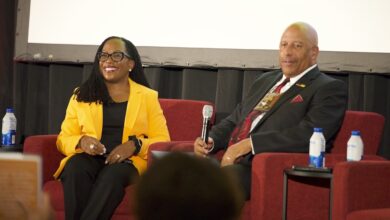
To hear John Price tell it, his work in experimental physics most resembles the preparation of an Ikea assembly guide.
“What I’m trying to do is better understand the structure of the atomic nucleus and its constituents–protons and neutrons,” says Price, professor of physics at CSUDH. “Let’s say you go to Ikea and purchase a proton construction kit. I’m one of the guys writing the book that explains how it gets put together.”
Price has spent the better part of two decades pioneering research into how short-lived beams can be used to better map atomic nuclei. It is in acknowledgement of this groundbreaking research that Price has been named the 2023 Excellence in Research, Scholarship, and Creative Activity Award. The award recognizes work by faculty on the frontier of their discipline that is an essential component of the university’s mission and that stimulates student learning.
Much of Price’s work takes place at the Thomas Jefferson National Accelerator Facility in Newport News, Va. “Any time you look at a proton with a particle accelerator, you’re limited in the properties that any given particle can access. I can shoot a proton at another proton, or an electron at a proton,” he says.
“But if I want to get a more complete picture, I have to find other particles with which I can probe the proton.”
Price has been the recipient of numerous Department of Energy grants for proton research that help fund student research trips to the Thomas Jefferson National Accelerator Facility in Virginia.
Those other particles include lambda particles–short-lived beams that decay after a mere 1/10 billionth of a second. A detector inside the accelerator tracks the movements, or scattering, of lambda particles from the moment they’re created to the moment they decay.
Price works with a team of about 200 other researchers from universities around the world to create and analyze data gathered by the detector. Undergraduate students also play an essential role, during visits to the accelerator and in the distributed computing lab on campus where much of the data gets evaluated.
“I work with a detector that’s three stories tall. My students and I built a good chunk of it,” says Price, adding that the sheer volume of data amassed daily–the equivalent of a modern-sized public library–requires dozens of networked computers and the use of custom algorithms to process.
The ability to get hands-on experience in cutting-edge research, learning how to conduct data analysis using distributed computer clusters, and having access to world-class scholars from around the world are only a few of the advantages that CSUDH physics students enjoy.
“The undergraduates in my lab know a tremendous amount more about nuclear physics than undergraduate physics majors in general,” Price says. “Well over 90 percent of them go on to graduate school, and the best of them I would happily put up against those of any other school in the country.”
Price has taught at CSUDH for nearly 18 years and says it’s the students that have kept him at the university. “The students at this school really appreciate what we do here,” he says.
“For me, research, scholarship, and creative activity really just mean all the things that we as faculty do that help our students get motivated to take the next step in whatever they’re doing after they leave us.”








